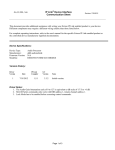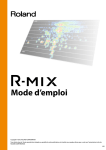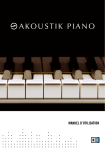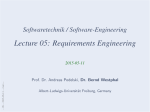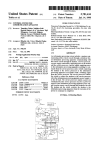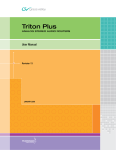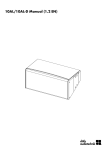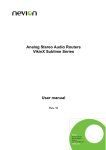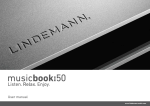Download XMIC 04_100605
Transcript
Stage Tec Professional Digital Audio-Routing And Mixing-Console Systems 2010-06-05 © Stage Tec Entwicklungsgesellschaft für professionelle Audiotechnik mbH, Berlin Stage Tec’s newly designed NEXUS 8-channel microphone A/D converter now digitizes analog input signals with a resolution of up to 32 bits. It processes input levels of up to 24 dBu without clipping, offering an outstanding dynamic range of 158 dB(A)! This A/D converter does not limit the microphone dynamics since the digital 32-bit signal includes the entire dynamic range of the microphone, making gain adjustments or analog preamplification of the microphone signal unnecessary. If subsequent processing is performed at a lower resolution, the control program allows for setting a digital gain of up to 70 dB. The aim of providing optimum audio quality has been achieved thanks to Stage Tec’s patented XMIC XMIC+04 Microphone-Input Board TrueMatch technology: The input stage is incorporated on the 32-bit converter while all other signal processes such as subsonic filtering, phase inversion, clip limiting, and gain settings are performed solely on the digital domain. Each of the XMIC converters provides four split outputs with separately adjustable gain and subsonic filters for different downstream consumers. The XMIC’s space requirements on the base device are exceptionally low: The board—which is just 3 U in height—contains eight quality converters. The board itself has a mounting depth of just 4 HP (about 20 mm); however, the XLR standard ports require 16 HP. Therefore, in addition to the XLR unit, versions featuring RJ 45 and D-Sub terminals with a footprint of just 4 HP are available for stationary installations. Thus, a single 3-U base may accommodate up to 160 of those quality microphone inputs. XMIC+ • 8 channels on 3 U x 4 HP • Integrated split amplifier (option) • 32-bit TrueMatch converters • Dynamic range: 158 dB(A)@24 dBu (typ.) • THD&N.: <0.003%@24 dBu • Negligible converter inaccuracies • Optimized aliasing rejection • True galvanic isolation using transformers • Ultra-low latency/exceptional pulse fidelity • Auto-mute function when connecting/disconnecting the microphone Stage Tec TrueMatch Technology The exceptional XMIC specifications could be achieved thanks to the TrueMatch principle, a patented converter technology of the latest generation. First-class analog circuit design and state-ofthe-art DSP technology form the basis of these new reference converters. Unlike conventional dynamic-enhancement techniques such as gain ranging, TrueMatch does not switch between a number of conversion curves. Typical side effects caused by switchover (e.g. suddenly changing noise levels) do not exist with TrueMatch converters. Minimized Conversion Errors TrueMatch A/D converters offer a permanent sample-based correction, resulting in a stable, almost perfect conversion curve with a minimum of errors over the entire conversion range. User Manual Ultra-Low THD TrueMatch A/D converters feature ultra-low THD over a wide level range. This wide range makes the use of TrueMatch converters uncritical. Homogenous Noise Spectrum TrueMatch A/D converters provide a homogenous noise spectrum over the entire conversion range. The intrinsic noise is practically not perceptible even at very low input levels. Significantly Better Aliasing Suppression Compared to conventional techniques, the TrueMatch technology provides significantly better aliasing suppression. Crystal-clear and transparent recording is now ensured even at the usually slightly critical sample rate of 44.1 kHz. XMIC – 467 Stage Tec Professional Digital Audio-Routing And Mixing-Console Systems Transformer-Isolated Input Stage Data Isolator Power DC/DC Isolator in addition, the input capacitance is very low, and the board achieves optimum balancing. DSP Power Businterface Input Stage &ADC THD&N at high output levels and low frequencies; NEXUS Busses Like all analog system inputs, the XMIC inputs are transformer-isolated and balanced, offering true galvanic isolation. The XMIC technology is insusceptible to magnetic fields and provides low ADC Board Fig.: Principle of true transformer isolation without a problematic input transformer Exceptional Dynamics ry, this range could be represented by a 28-bit resolution; however, the higher resolution of the XMIC converter also utilizes the noise produced by the input stage and the connected microphone for generating “natural” dither, thus reducing the inevitable quantization noise to below the microphone noise. That is, the intrinsic (microphone/inputstage) noise masks the quantization noise within the useful signal. Resulting Converter Features • The dynamic range of the converter exceeds the respective values of any conventional microphones. • The 32-bit resolution covers the entire utilizable signal – from the noise floor to the microphone-clipping limit. • Even very low levels are digitized with high resolution. • Featuring a maximum input voltage of 24 dBu (@ 0 dB gain), the converter can virtually not be overdriven by typical studio units. Thus, the XMIC can also be used as a fully adequate line-input unit. • Gain and signal-processing settings are made on the digital domain after the A/D conversion, therefore not affecting the signal quality. Because of their floatingpoint arithmetic capabilities, Stage Tec consoles can fully utilize the dynamic range, so gain settings are made only with regard to the target medium. The World of 24-Bit Digital Signals Depending on the standard used, digital audio signals are transmitted with a word length of 24 bits (AES/EBU, MADI) or less. In theory, the 24-bit resolution provides for a dynamic range of about 144 dB. As the XMIC’s converter dynamics is much better than that of the downstream digital medium, the board provides a gain function. The maximum adjustable gain is 70 dB. The above theoretical approach of recording the unprocessed signal with full 32-bit resolution 468 and putting off the gain setting to the post-processing stage is hard to implement in practice due to the prevailing use of 24-bit formats. In order to avoid this limitation, highly dynamic signals might be recorded to separate tracks: the unamplified converter signal goes to one track while another one is fed from a split output of the same converter configured with a fixed gain setting. Depending on the signal level, the alternative track can still be used for processing fortississimo or pianississimo signals. NEXUS – Digital Audio-Routing and Interconnect System 2010-06-05 © Stage Tec Entwicklungsgesellschaft für professionelle Audiotechnik mbH, Berlin The intrinsic noise of the XMIC input stage is –133,6 dBu(A), which is less than the noise produced by a 200-ohm resistance! (This value was determined at a source impedance of 0 ohm to ensure that the converter quality and not the connected source is measured. Complex measuring setups are required for determining those extremely low voltages to make sure that measuring errors due to external influence are largely ruled out. Any stray pickup—or even cable noise—would affect the measurement. Therefore, the source impedance must be located immediately on the shielded XLR input jack.) As the total noise level of the input stage and the converter is below that produced by an Ohmic resistance, the noise floor produced by the microphone impedance (about –128 dBu depending on the actually used microphone) predominates the overall signal. Moreover, the noise floor produced by the condenser-microphone amplifier is not yet considered! Thus, the dynamic range achievable using the XMIC mostly depends on the intrinsic noise of the microphone used. The maximum input level that board can handle without clipping is 24 dBu. Such “line” signals can be directly applied to the XMIC—a pad function as it is needed by other microphone amplifiers/converters is not required here. The key specifications indicate a dynamic range of 157.6 dB for the XMIC converter. In theo- Target Formats 16-bit target system Due to the provided gain function, the converter can also be used for recording to low-resolution media. For example, when recording to a 16-bit machine, the gain must be set appropriately to utilize the limited 16-bit dynamic range of (in theory) 96 dB. Usually, very little or no headroom at all will typically be set during recording to optimally utilize this low resolution. 16-bit formats make sense only for creating consumer target formats; however, the conversion should be the last step in the process. Creating 16-bit recordings for serious post-processing is basically questionable. 20-bit target system A 20-bit resolution provides a dynamic range of 120 dB. Gain is less criti- cal here: There is still an effective dynamic range of 100 dB even at a headroom of 20 dB. 24-bit target system When using 24-bit resolution, the resulting dynamic range of 144 dB already exceeds the dynamic range of the microphone. The signal fed from the microphone can be recorded with no extra processing. Gain settings, equalization, and even the use of a subsonic filter can be postponed to the post-recording stage. Digital clipping spoiling recordings is now over and done with—perfect for live recording, live interviews and reports, and theaters; not to mention OB vans. Processing on the Digital Domain The combination of extensive dynamics and the converter principle allows for moving all signal-affecting filtering typical of microphone preamps to the digital domain. For example, subsonic filters (20, 40, 60, or 80 Hz, 18 dB/oct.) can be accurately computed and precisely applied; since they are not contained in the sensitive analog part of the signal path, they do not cause any audio deterioration. The recommended way of operation is to record the input audio directly to a hi-resolution medium while not altering the original level. All signal processing including level changes occurs in a non-destructive way only after recording. However, as not all environments support this approach, the converters include an adjustable gain function. This can be set between 0 and 70 dB and is made on the digital domain, too. Limiter To avoid clipping of amplified signals, each splitter output features an extra on-board limiter that can also be disabled. This ultra-fast limiter (fixed settings; attack time: 0 samples) responds at a level of only –0.06 dBFS, so audio signals will not be affected at normal working levels. Split Out System Lo Cut Filter Phase Gain Limiter Chn 1 Out A Lo Cut Filter Phase Gain Limiter Chn 1 Out B Lo Cut Filter Phase Gain Limiter Chn 1 Out C Lo Cut Filter Phase Gain Limiter Chn 1 Out D +48 V TrueMatch ADC NEXUS Busses XMIC Businterface 2010-06-05 © Stage Tec Entwicklungsgesellschaft für professionelle Audiotechnik mbH, Berlin Perfectly Integrated Splitter Function A/D Channel 1 Oscillator Channel 2 Channel 8 Fig.: Each of the eight XMIC converters offers four separate outputs with individually adjustable parameters. User Manual XMIC – 469 XMIC Stage Tec Professional Digital Audio-Routing And Mixing-Console Systems Stage Tec Professional Digital Audio-Routing And Mixing-Console Systems The splitter function requires the NEXUS Matrix 5 control software or later. The XMIC is the first unit incorporating a splitter directly on the board. The converted signal is forwarded via four separate outputs to the NEXUS TDM bus and can thus be made available to four different consumers. Signal processing is made individually for each of those paths. (Of course, the signal can still be made available to other consumers using the standard crosspoint routing.) In the past, the various consumers of a microphone source had to agree upon common settings for converter gain and filters. For example, changing the gain at one workplace affected all consumers. Changes were possible only using the internal processing functions of the console or by mutual agreement. Now, using the XMIC, the FOH engi- neer can make other gain and filter settings than the monitoring engineer or the operator in the OB van. In systems, where NEXUS user-rights are implemented, the displayed inputs can be restricted, so every workplace only accesses “its” sources. Each of the eight converters on an XMIC supports the splitter function, so the entire board offers 32 outputs. (That is, NEXUS matrix windows show 32 items. The four splitter outputs of the individual converters have the “A”…“D” extensions.) Note: Phantom power can be enabled or disabled from each workplace (Boolean OR operation). Naturally, this setting will affect all workplaces. Auto Mute It is sufficiently known that the microphone should not be physically connected to or disconnected from the input jack while the fader is open. Nevertheless, this happens every day, affecting the hearing of your colleagues (and sometimes even the audience) as well as your speakers. The XMIC puts an end to this problem: An intelligent circuitry detects whenever the connector is inserted or removed and mutes the signal for an instant. Variant Types Stage Tec offers the following A/D converter variants: • XAD+ (8-channel version, 24-dBu input level) • HXAD (8 stereo converters) Versions and Options The following XMIC types are available: Ausführungen XMIC+ 4 XLR ports (3-pole, female) for inputs 1…4; the inputs 5…8 (same configuration) are located on a separate front panel* XMIC+-RJ 2 RJ45 ports (for all channels) XMIC+-DSUB Optionen 25-pole D-Sub port The RJ45-ADP adapter PCB is available for connecting signal sources requiring XLR ports. * The 8-HP front panel of the board includes four XLR ports for inputs 1 to 4. A second front panel offers inputs 5 to 8 and can be installed, for example, in a (reasonably priced) base-device row without a backplane just below or above the row containing the XMIC. With the D-Sub and RJ versions designed for stationary installations, all inputs are contained on a 4-HP front panel. Instead of simple XLR ports, XLR/1/4" combo ports are implemented on request. Table: XMIC Versions and Options TrueMatch RMC The XMIC microphone-input board is not only used on the NEXUS routing system but is also implemented on the 24-channel TrueMatch RMC , making the outstanding audio quality available to other applications. (There is also a line-input version of this standalone converter device based on the XAD A/D converter board by Stage Tec.) Existing (even analog) installations can be easily extended and upgraded: Remastering The TrueMatch RMC converts the analog output signal of a multitrack recording ma- 470 chine. This high-quality digital signal is then stored with a resolution of 24 bits to a modern storage device. Music Production The simple converters used in numerous cheap digital mixing consoles are bypassed by an upstream TrueMatch RMC . Live Recording Thanks to its compact size, the TrueMatch RMC can be used “on the spot”. The sensitive analog microphone signals are connected via very short lines. NEXUS – Digital Audio-Routing and Interconnect System 2010-06-05 © Stage Tec Entwicklungsgesellschaft für professionelle Audiotechnik mbH, Berlin Adapter RJ45/XLR Stage Tec Professional Digital Audio-Routing And Mixing-Console Systems XMIC Block Diagram NEXUS Busses Channel 1 +48 V 6k8 Pin 2 RF-Cut Input Stage Pin 3 TrueMatch ADC A/D +48 V Pin 2 Businterface Pin 1 DSP (Gain, Lo-Cut, Limiter, DC-Filter) Channel 8 RF-Cut Input Stage Pin 3 TrueMatch ADC A/D Pin 1 Oscillator XMIC 8 Channel Microphone ADC Fig.: XMIC+ schematic diagram Jumpers and terminals The PCB does not incorporate any jumpers or terminals relevant to the user. 2010-06-05 © Stage Tec Entwicklungsgesellschaft für professionelle Audiotechnik mbH, Berlin Circuit Board XMIC04 Fig.: XMIC+ PCB User Manual XMIC – 471 Stage Tec Professional Digital Audio-Routing And Mixing-Console Systems Technical Specifications XMIC04+ Specifications Inputs Channel configuration Subsonic filter Limiter Unless otherwise indicated, all specifications are based on the following conditions: All measurements comply with the IRT standards (“IRT Pflichtenheft 3/2”, issued in July 1982, and “IRT Pflichtenheft 3/5”, issued in October 1990) and AES standards (AES-17, issued in 1998). Ref. rate: 1 KHz. Sample rate: 48 KHz. Full-scale level: 0 dBFS = 24 dBu 8 channels per board, balanced; floating transformer isolation XLR-3 (female), gold-plated contacts (XLR-3/1/4" combo socket available on request); or RJ45 port, EN 50173-compliant pinout, for S/STP (CAT5) line; or 25-pole D-Sub port • Adjustable digital gain • 48-V phantom power • Subsonic filter, Phase inversion • Limiter (fixed settings, requires XCPU08 and Matrix5 software or later) Switchable between 20/40/60/80 Hz, 18 dB/oct. Threshold Attack Time –0,06 dBFS 0 samples Hold Time 10 ms Release Time 0.5 s Ratio limit Input level 24 dBu balanced (max.); unbalanced input signal (up to 24 dBu) with phantom power disabled Phantom power 11 mA (max.), fused; can be enabled/disabled Dielectric strength Frequency response < ±200 V (common-mode signal, with disabled phantom power) 20…20,000 Hz < 0.05 dB (< ±0.1 dB typ.) @ 20 Hz Input impedance –3 dB (typ.) (18-dB/oct. slope below, in compliance with IRT specifications) 12.5 kilohm with phantom power disabled 6.4 kilohm with phantom power enabled Input-impedance CMR 125 dB@50 Hz (typ.) Gain 105 dB@1 KHz (typ.) 80 dB@20 KHz (typ.) Up to 70 dB (clickfree digital adjustment in 1-dB steps) THD&N 0.003%@24 dBu (typ.); <0.004% granted 0.003%@–50…0 dBu (typ.); < 0.004% granted Dynamic range >144 dB (RMS) or >147 dB (A), limited by the 24-bit output format 157,6 dB(A) total range Idle-channel noise Equivalent input-noise level –155.5 dBFS CCIR-RMS @ 0-ohm input impedance (typ.) < –129,5 dBu(A) @ 200 ohm input impedance < –126 dBu(RMS) @ 200 ohm input impedance < –115 dBqp CCIR1K @ 200-ohm input impedance Crosstalk attenuation > 140 dB ( @ 20…20,000 Hz) > 170 dB @ 1 KHz (typ.) HF resistance > 150 dB @ 20 KHz (typ.) HF-demodulation resistant according to IRT standards (IRT-Pflichtenheft 3/5) and European standards A/D conversion Stage Tec TrueMatch Delta-Sigma converter Resolution 32 bit, 218 times oversampling Sample rate 44.1 kHz, 48 kHz, 96 kHz (system-specific) Latency 395 µs @ 48-KHz sample rate Power supply Voltage +4.75…5.25 V Operating conditions Current Temperature range 1200 mA 0…+50°C Humidity 90% (max.), non-condensing Temperature range –35…+70°C Humidity 90% (max.), non-condensing Appearance Board for 19" module frame; 3 U, 340 mm Front panel 4/8 HP (20.02 or 40.2 mm x 128.5 mm), version-specific Slot requirements Weight 1 0.32 kg Storage conditions Physical properties Table: XMIC04+ Specifications 472 NEXUS – Digital Audio-Routing and Interconnect System 2010-06-05 © Stage Tec Entwicklungsgesellschaft für professionelle Audiotechnik mbH, Berlin < –133,6 dBu(A) @ 0 ohm input impedance Pinout Various board versions with different port configurations are available. With standard ports (XLR , 1/4"), the pinout complies with the respective specifications, so prefabricated cabling can be used. (RJ 45 ports have an EN 50173-compliant wiring; for information on special-purpose solutions such as D-Sub ports, etc., refer to the figure below.) 2010-06-05 © Stage Tec Entwicklungsgesellschaft für professionelle Audiotechnik mbH, Berlin Fig.: XMIC+ pinout User Manual XMIC – 473 XMIC Stage Tec Professional Digital Audio-Routing And Mixing-Console Systems







